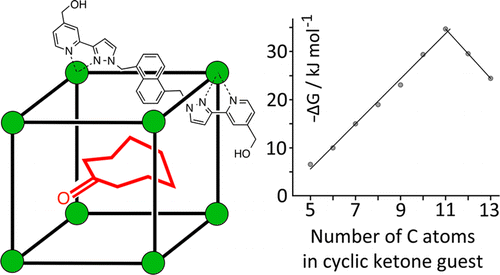当前位置:
X-MOL 学术
›
J. Am. Chem. Soc.
›
论文详情
Our official English website, www.x-mol.net, welcomes your
feedback! (Note: you will need to create a separate account there.)
Mapping the Internal Recognition Surface of an Octanuclear Coordination Cage Using Guest Libraries
Journal of the American Chemical Society ( IF 14.4 ) Pub Date : 2014-05-29 , DOI: 10.1021/ja504269m Simon Turega 1 , William Cullen 1 , Martina Whitehead 1 , Christopher A. Hunter 1 , Michael D. Ward 1
Journal of the American Chemical Society ( IF 14.4 ) Pub Date : 2014-05-29 , DOI: 10.1021/ja504269m Simon Turega 1 , William Cullen 1 , Martina Whitehead 1 , Christopher A. Hunter 1 , Michael D. Ward 1
Affiliation

|
Size and shape criteria for guest binding inside the cavity of an octanuclear cubic coordination cage in water have been established using a new fluorescence displacement assay to quantify guest binding. For aliphatic cyclic ketones of increasing size (from C5 to C11), there is a linear relationship between ΔG for guest binding and the guest's surface area: the change in ΔG for binding is 0.3 kJ mol(-1) Å(-2), corresponding to 5 kJ mol(-1) for each additional CH2 group in the guest, in good agreement with expectations based on hydrophobic desolvation. The highest association constant is K = 1.2 × 10(6) M(-1) for cycloundecanone, whose volume is approximately 50% of the cavity volume; for larger C12 and C13 cyclic ketones, the association constant progressively decreases as the guests become too large. For a series of C10 aliphatic ketones differing in shape but not size, ΔG for guest binding showed no correlation with surface area. These guests are close to the volume limit of the cavity (cf. Rebek's 55% rule), so the association constant is sensitive to shape complementarity, with small changes in guest structure resulting in large changes in binding affinity. The most flexible members of this series (linear aliphatic ketones) did not bind, whereas the more preorganized cyclic ketones all have association constants of 10(4)-10(5) M(-1). A crystal structure of the cage·cycloundecanone complex shows that the guest carbonyl oxygen is directed into a binding pocket defined by a convergent set of CH groups, which act as weak hydrogen-bond donors, and also shows close contacts between the exterior surface of the disc-shaped guest and the interior surface of the pseudospherical cage cavity despite the slight mismatch in shape.
中文翻译:

使用访客库绘制八核坐标笼的内部识别面
使用一种新的荧光置换测定法来量化客体结合,已经建立了水中八核立方配位笼腔内客体结合的大小和形状标准。对于越来越大的脂肪环酮(从 C5 到 C11),客体结合的 ΔG 与客体的表面积之间存在线性关系:结合的 ΔG 变化为 0.3 kJ mol(-1) Å(-2),对应于客体中每个额外的 CH2 基团的 5 kJ mol(-1),与基于疏水去溶剂化的预期非常一致。环十一酮的最高缔合常数为 K = 1.2 × 10(6) M(-1),其体积约为腔体积的 50%;对于较大的 C12 和 C13 环酮,随着客体太大,缔合常数逐渐减小。对于一系列形状不同但大小不同的 C10 脂肪族酮,客体结合的 ΔG 与表面积没有相关性。这些客体接近空腔的体积限制(参见 Rebek 的 55% 规则),因此缔合常数对形状互补性很敏感,客体结构的微小变化会导致结合亲和力的巨大变化。该系列中最灵活的成员(线性脂肪族酮)没有结合,而更预先组织的环酮都具有 10(4)-10(5) M(-1) 的关联常数。笼·环十一酮复合物的晶体结构表明,客体羰基氧被引导到由一组收敛的 CH 基团定义的结合口袋中,这些 CH 基团充当弱氢键供体,
更新日期:2014-05-29
中文翻译:

使用访客库绘制八核坐标笼的内部识别面
使用一种新的荧光置换测定法来量化客体结合,已经建立了水中八核立方配位笼腔内客体结合的大小和形状标准。对于越来越大的脂肪环酮(从 C5 到 C11),客体结合的 ΔG 与客体的表面积之间存在线性关系:结合的 ΔG 变化为 0.3 kJ mol(-1) Å(-2),对应于客体中每个额外的 CH2 基团的 5 kJ mol(-1),与基于疏水去溶剂化的预期非常一致。环十一酮的最高缔合常数为 K = 1.2 × 10(6) M(-1),其体积约为腔体积的 50%;对于较大的 C12 和 C13 环酮,随着客体太大,缔合常数逐渐减小。对于一系列形状不同但大小不同的 C10 脂肪族酮,客体结合的 ΔG 与表面积没有相关性。这些客体接近空腔的体积限制(参见 Rebek 的 55% 规则),因此缔合常数对形状互补性很敏感,客体结构的微小变化会导致结合亲和力的巨大变化。该系列中最灵活的成员(线性脂肪族酮)没有结合,而更预先组织的环酮都具有 10(4)-10(5) M(-1) 的关联常数。笼·环十一酮复合物的晶体结构表明,客体羰基氧被引导到由一组收敛的 CH 基团定义的结合口袋中,这些 CH 基团充当弱氢键供体,






























 京公网安备 11010802027423号
京公网安备 11010802027423号